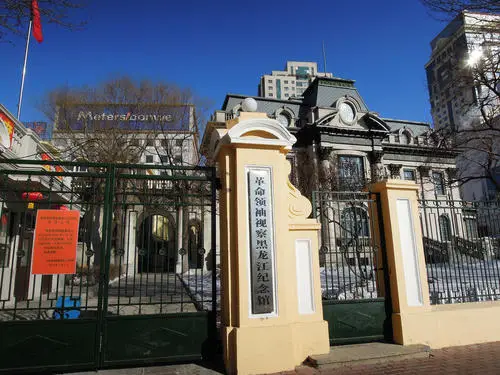This building was constructed in 1909 and was originally a luxurious residence built by a Polish timber merchant named Gwalish. The building has served various purposes over the years: from a private residence of a Polish timber merchant, to a high-level club of the China Eastern Railway during the Japanese puppet regime, to the headquarters of the Soviet Red Army in Harbin during the liberation of Northeast China, to the office of the General Command of the Northeast Democratic United Army during the Liberation War, to a school for the children of cadres of the Northeast Democratic United Army, and finally, after liberation, it became the guesthouse of the Harbin Municipal Government of Songjiang Province. After the founding of the People's Republic of China, revolutionary leaders such as Mao Zedong, Zhou Enlai, Liu Shaoqi, Zhu De, Zhang Wentian, and Soong Ching-ling worked and lived here during their inspections of Heilongjiang. In 1975, the Revolutionary Leaders' Inspection of Heilongjiang Memorial Hall was established and opened to the public for free.
Alekseyev Church
Then take a car to St. Alekseyev Church, which was built in 1931. It is a typical Russian-style building. Initially, it was an Orthodox church, but after being restored in 1980, it was converted into a Catholic church. St. Alekseyev Church was originally a military church in Gongzhuling. After the troops were redeployed, it was moved here with the Russian army. On February 25, 1912, a wooden church was built here (demolished on July 13, 2000, during the reconstruction of the surrounding environment). In October 1930, next to the wooden church, the construction of this existing brick church began, and it was completed on October 6, 1935. After the reform and opening up, the relevant departments renovated the church and assigned it to the Harbin Catholic Church. The church officially opened on Christmas in 1980.
You can see the Heilongjiang Museum when you arrive at Hongbo Square. It is a very prominent building, originally built in 1906. The main building is a European Baroque-style structure, originally the site of the Russian Mall. With the establishment of the Middle East Railway, Russian scholars proposed the establishment of a museum, converting the original Moscow Mall (now the main building of the provincial museum) into an exhibition hall for the research society. On June 12, 1923, the Dongsheng Cultural Relics Research Society Exhibition Hall was established here and opened to the public. During the puppet Manchukuo period, it served as the Cultural Relics Research Institute of the Puppet North Manchuria Special Zone. After liberation, it was transformed into the Heilongjiang Provincial Museum Industrial University Scientific Research Institute in Harbin. In 1951, China began to take over and renamed it the Songjiang Provincial Science Museum. In 1953, it was renamed the Songjiang Provincial Museum. In 1954, with the merger of Songjiang Province into Heilongjiang Province, the Songjiang Provincial Museum merged with the Heilongjiang Provincial Museum Preparatory Office and was officially named the Heilongjiang Provincial Museum.
Meyerovich Building
From the museum, you can see a yellow building, the Meyerovich Building, also known as the Meyerovich Palace. Historically, it has been called the 'Lotus Art School.' It is located southeast of Hongbo Square and has always been referred to as 'Custard.' This building was completed in 1921, and the designer was Yu P. Zhdanov. The theme of the architecture is classical columns, typical of the French Renaissance style. Initially, the first floor of the 'Meyerovich Palace' was the Popivorinsky Hospital, established in March 1921. In the 1920s, it became a gathering place for Russian intellectuals who fled to Harbin after the October Revolution. Russian painter Kichkin came to Harbin and established the 'Lotus Studio' on the third floor. Later, it became the Qiulin Company Employee Club. After liberation, it became the Harbin Children's Palace. Especially during that time, many table tennis players were trained here, producing generations of national table tennis champions like Han Yuzhen and Kong Linghui.
Middle East Railway Impression Museum
The exhibition hall focuses on the Middle East Railway and unfolds the entire development history of the city of Harbin.













